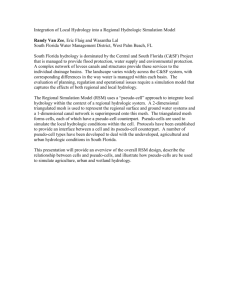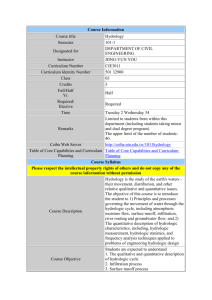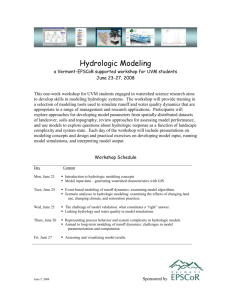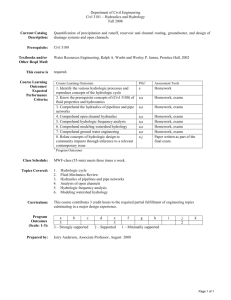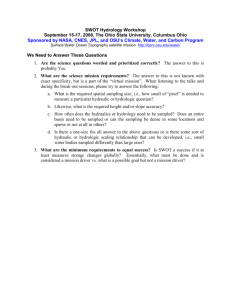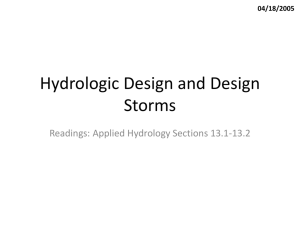Text: Hydrology and Floodplain Analysis, Third Edition
advertisement
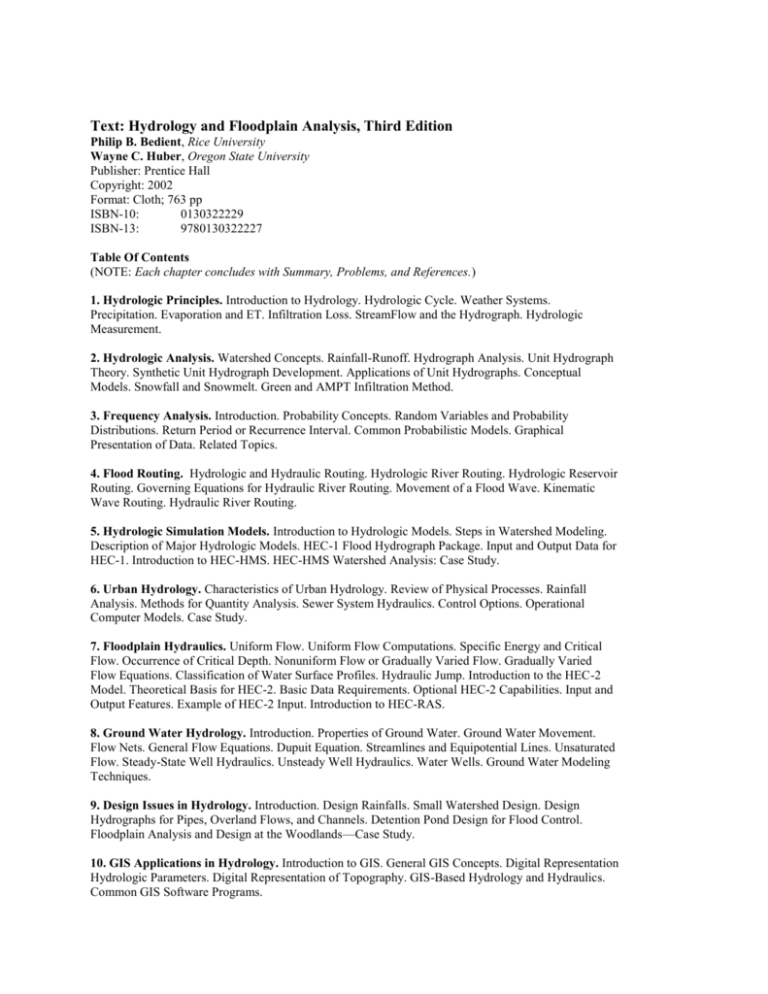
Text: Hydrology and Floodplain Analysis, Third Edition Philip B. Bedient, Rice University Wayne C. Huber, Oregon State University Publisher: Prentice Hall Copyright: 2002 Format: Cloth; 763 pp ISBN-10: 0130322229 ISBN-13: 9780130322227 Table Of Contents (NOTE: Each chapter concludes with Summary, Problems, and References.) 1. Hydrologic Principles. Introduction to Hydrology. Hydrologic Cycle. Weather Systems. Precipitation. Evaporation and ET. Infiltration Loss. StreamFlow and the Hydrograph. Hydrologic Measurement. 2. Hydrologic Analysis. Watershed Concepts. Rainfall-Runoff. Hydrograph Analysis. Unit Hydrograph Theory. Synthetic Unit Hydrograph Development. Applications of Unit Hydrographs. Conceptual Models. Snowfall and Snowmelt. Green and AMPT Infiltration Method. 3. Frequency Analysis. Introduction. Probability Concepts. Random Variables and Probability Distributions. Return Period or Recurrence Interval. Common Probabilistic Models. Graphical Presentation of Data. Related Topics. 4. Flood Routing. Hydrologic and Hydraulic Routing. Hydrologic River Routing. Hydrologic Reservoir Routing. Governing Equations for Hydraulic River Routing. Movement of a Flood Wave. Kinematic Wave Routing. Hydraulic River Routing. 5. Hydrologic Simulation Models. Introduction to Hydrologic Models. Steps in Watershed Modeling. Description of Major Hydrologic Models. HEC-1 Flood Hydrograph Package. Input and Output Data for HEC-1. Introduction to HEC-HMS. HEC-HMS Watershed Analysis: Case Study. 6. Urban Hydrology. Characteristics of Urban Hydrology. Review of Physical Processes. Rainfall Analysis. Methods for Quantity Analysis. Sewer System Hydraulics. Control Options. Operational Computer Models. Case Study. 7. Floodplain Hydraulics. Uniform Flow. Uniform Flow Computations. Specific Energy and Critical Flow. Occurrence of Critical Depth. Nonuniform Flow or Gradually Varied Flow. Gradually Varied Flow Equations. Classification of Water Surface Profiles. Hydraulic Jump. Introduction to the HEC-2 Model. Theoretical Basis for HEC-2. Basic Data Requirements. Optional HEC-2 Capabilities. Input and Output Features. Example of HEC-2 Input. Introduction to HEC-RAS. 8. Ground Water Hydrology. Introduction. Properties of Ground Water. Ground Water Movement. Flow Nets. General Flow Equations. Dupuit Equation. Streamlines and Equipotential Lines. Unsaturated Flow. Steady-State Well Hydraulics. Unsteady Well Hydraulics. Water Wells. Ground Water Modeling Techniques. 9. Design Issues in Hydrology. Introduction. Design Rainfalls. Small Watershed Design. Design Hydrographs for Pipes, Overland Flows, and Channels. Detention Pond Design for Flood Control. Floodplain Analysis and Design at the Woodlands—Case Study. 10. GIS Applications in Hydrology. Introduction to GIS. General GIS Concepts. Digital Representation Hydrologic Parameters. Digital Representation of Topography. GIS-Based Hydrology and Hydraulics. Common GIS Software Programs. 11. Radar Rainfall Applications in Hydrologic. Introduction. Radar Estimation of Rainfall. WSR-88D Radar System. Real-Time WSR-88D Precipitation Products. Radar to Gage Calibration. Linkages with Hydrologic Modeling. 12. Floodplain Management Issues in Hydrology. Introduction. The Era of Federal Structural Flood Control Measures. The Federal Emergency Management Agency. Floodplain Management Issues. Structural Methods of Flood Control. The Flood Control Paradox. Nonstructural Methods of Flood Control. Clear Creek Case Study: A GIS-Based Approach. Appendix A. Symbols and Notation. Appendix B. Metric Conversion Factors (SI Units to U.S. Customary). Appendix C. Properties of Water. Appendix D. Normal Distribution Tables. Appendix E. Useful Hydrology-Related Internet Links. Glossary. Index.



